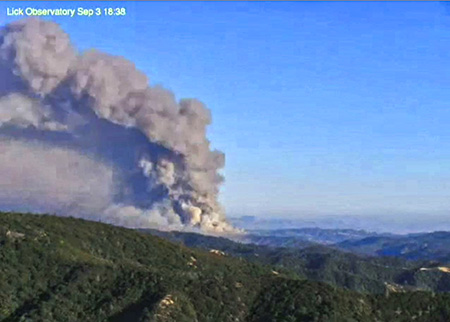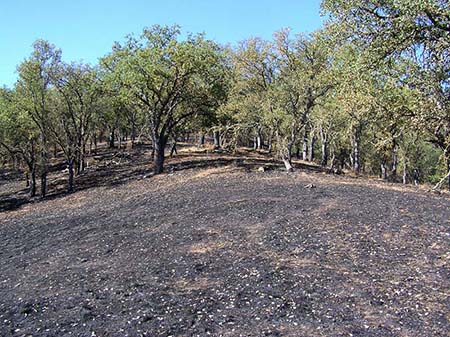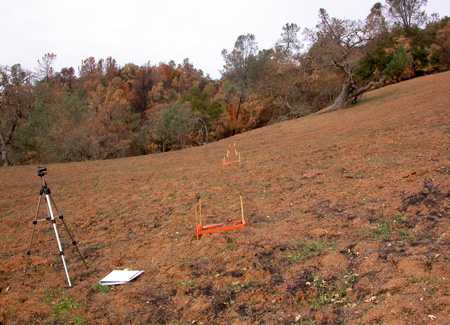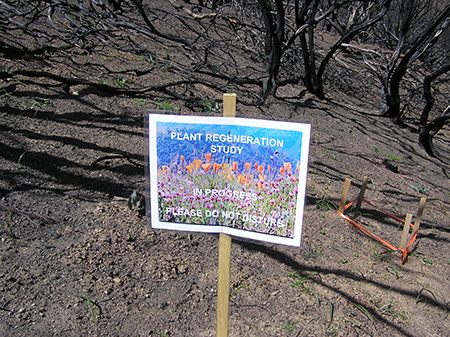Writing a Coe Park Diary Through The Aftermath Of A Fire
Dr. Winslow R. Briggs
In the middle of the day on September 3, 2007, a small plume of smoke emerged from behind Blue Ridge. This was to grow into a conflagration that was to consume 47,600 acres most of it in Henry W. Coe State Park. Started accidentally, it was only with massive backfires that the exhausted firefighters were finally able to stop it. Since the fire was originally thought to be near the Lick Observatory it was named the Lick Fire.

Hamcam view of the Lick Fire on September 3, 2007
Was it a catastrophe? Likely some small animals were caught in it and a few larger ones, though to date evidence is scant.
Was the area over-ripe for fire? The answer for much of the burned area is a resounding yes. Dense stands of chamise choked the steep hillside. Chamise is not called "greasewood" for nothing as it is high inflammable. Has fire been a regular visitor? The Bollinger fire in 1961 covered much of the same area. Most of our chaparral stands and inland forests have burned repeatedly through centuries.
Is fire a regular part of the ecology? Absolutely. Fire has shaped plant communities for millennia. The following provide some of the evidence: There are some plant species whose seeds germinate poorly if at all unless heated. Buck brush (Ceanothus leucodermis ), a common chaparral shrub in the park, has seeds that are stimulated to germinate by a heat shock. Chamise (Adenostemma fasciculta ), found in dense stands throughout the park, requires not heat but some factor in smoke to induce its seeds to germinate. Consider the bishop pine (Pinus muricata ), in the Point Reyes National Seashore, or the knobcone pine (Pinus attenuata ), found in dry areas of Big Basin State Park. Both have cones that hold the seeds tightly until a heat shock induces the scales to separate and release the seeds. Two years after fire swept through groves of bishop pine on the National Seashore some years back the ground was a veritable lawn of bishop pine seedlings. Clearly these species would not still be with us unless there had been repeated fires over the centuries.
The Lick fire has provided us with a spectacular natural laboratory to follow the regenerative processes that occur after a fire. What sorts of questions are we addressing? First, what effect did fire intensity have on vegetation recovery? For example we have chaparral where the leaves were scorched but are still very much in evidence. We have chaparral where charred skeletons still stand starkly on the hillsides, every leaf consumed. And we have chaparral that was literally burned to the ground with only charred stumps protruding a few inches above the blackened soil—real moonscapes.

A "moonscape near Bear Mountain Road
These clearly represent increasing degrees of fire intensity. The groves of blue oak provide another example: In some areas the fire swept through the understory so rapidly that it scarcely charred the trunks and the leaves remained green.

The fire swept through the understory so rapidly that these trunks were scarcely scorched
In other areas the fire was slower and more intense and the leaves are all severely scorched. In still other areas the fire crowned and the leaves were all destroyed. We have identified a similar series of gray pine communities. A simple question arises: How much damage does it take to kill a particular tree or chaparral shrub species?
Since some plant species have seeds that require heat or smoke , we might expect to see some unusual plants appearing the first year after the fire and we'll be watching for them. These species will be far rarer the second year and may disappear completely the third year. In adition, those of our familiar species that come up the first year with the great infusion of nutrients and nitrogen dropped into the soil by the fire will not come up with the same frequency in the second and third year. How will this change? How will it change as a function of relative fire intensity?
Landsat satellite images provide us with the opportunity to monitor the relative capacity of the landscape to do photosynthesis.

Landsat image taken 0n 9/16/2009 showing variations in photosynthesis in the area around the fire
How will this change over time? Is the recovery rate different for different plant communities? We will be able to follow the changes with images taken every month or so for the duration of the study. We have identified 34 study sites for monitoring vegetation changes on the ground and changes in the surrounding trees and shrubs. Each site has five 50 x 50 centimeter quadrats marked out at ten-meter intervals and each quadrat is to be monitored on at least a monthly basis to record species appearance. Trees and shrubs that have suffered varying degrees of damage will be photographed and monitored for any recovery signs. Some 32 volunteers have been through two or more training sessions and are equipped with cameras and GPS instruments that will allow them to obtain precise records of the many recovery processes. The observations are already beginning, limited only by whether the roads are dry enough for vehicle access.

Study Quadrats
We are already beginning to see and record things that are happening. Even those charcoal lumps in the moonscape turn out to be chamise lumps that somehow retained some living tissue through what must have been a firestorm.

Stump Sprouting Chamise
Tiny green shoots are emerging from the charcoal. Some sort of lily (probably Zigadenus fremontii) is coming up in profusion in areas that were once solid chamise with no vegetation below their canopy.

Zigadenus fremontii where only chamise grew before
I have always thought that the massive stands of manzanita at the south end of Blue Ridge were our signature big-berry manzanitas . However, unlike the chamise, big-berry manzanitas don't regenerate from the charred stumps. They can only regenerate from seeds . Nevertheless, some of the burned manzanitas are clearly producing healthy shoots at their bases. Big-berry manzanitas don't have any fine hairs on the young and elongating green stems. By contrast, Eastwood's manzanita has young green shoots literally covered with fine hairs. It doesn't take very close inspection to see that even some of the very large shrubs are Eastwood's and not big-berry manzanitas. Which species will come to dominate this massive stand of Manzanita skeletons?

Stump Sprouting Eastwood's Manzanita
There are going to be many other surprises as the study progresses. Trees and shrubs that appeared severely damaged will nevertheless make it another year. Which species do better? Plants that haven't been seen for decades will make a surprise appearance. Many of the most interesting changes will happen over several years so we will have to be patient. We expect this study to go on for at least three years, perhaps even longer, so watch this space. As fascinating things occur out there, we'll bring you up to date.

A Study Quadrat
Note: As you wander about the park, you will recognize our quadrats by the orange flagging tape and special signs. Please stay well away from them to avoid disturbing them in any way!

Please Do Not Disturb
Seeds on your clothes or boots could contaminate the study plots
---
Dr. Winslow R. Briggs, Director Emeritus at Carnegie Institution of Washington's Department of Plant Biology, has been a Coe Park Volunteer for more than 30 years
|











